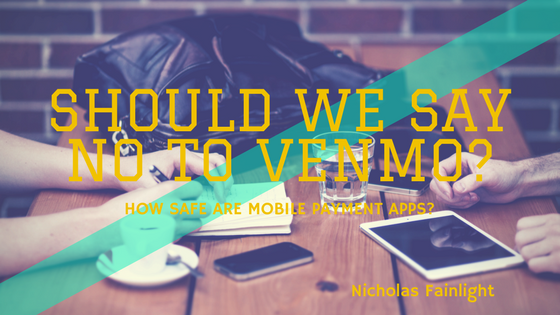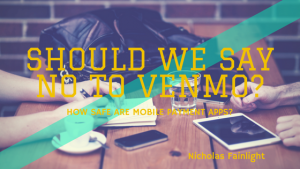As a college student as well as a Finance major, I’ve learned to be pretty frugal when it comes to spending my hard-earned cash. I realize the importance of investing and maintaining a healthy savings account. So I try to limit my nights out when I can because they usually entail spending a decent amount of money. But hey, I’m still a college student, so there will inevitably be pizza deliveries, trips to the movies, and dinners with friends. I don’t always carry a lot of cash on me and trying to split a bill between multiple people can be a hassle, so when I first heard about Venmo ( and other mobile payment apps like it), it sounded too good to be true!
Venmo certainly makes my life easier when I go out with friends. Rather than trying to figure out what everyone owes, or opting to split the bill evenly and having to carry a bunch of cash around, one person can just cover the bill and everyone else can transfer funds to that person through the app. Sounds pretty simple, right? Well, while I haven’t personally had any problems with Venmo or any other mobile payment app, there is a reason this technology, though efficient and convenient, hasn’t taken over traditional payment methods yet.
So, to answer my own question, I do not believe mobile payment technology should be dismissed because it certainly has its advantages. However, consumers using any of the plethora of mobile payment apps on the market should be wary, and here’s why.
In terms of digital payment technology, credit cards have been around for quite a while now. Even though the EMV (chip) cards are still a new trend in the United States, the transition has been fairly smooth. Credit payments have become the norm, but when they were first introduced, the results were disastrous. According to mentalfloss.com,when the Bank of America rolled out the first credit cards in 1958, they didn’t foresee any complications with the idea of letting customers accumulate debt with interest, as opposed to paying off their balances at the end of every month. However, the bank’s credit card system, BankAmericard, was met with fraud and declined payments left and right. The BankAmericard lost $20 million in its first year on the market, which equates to $150 million in today’s money. Fast forward to 1976 though, and the credit card had worked out all its kinks. The Bank of America introduced the card we all know and love today, Visa, and the rest is history.
Mobile payment apps are on fire right now and, as the credit card anecdote illustrates, there are some kinks that still need to be worked out with this new technology before it can become widely accepted. Today, it all comes down to data. The reason there is an overabundance of mobile payment apps being released from retailers (such as CVS, Walmart, and Starbucks), banks, and technology companies is because they are fighting simultaneously to maintain ownership of their customers, even if it means investing money in the development of these apps. It’s not about making the most money, but staying on the cutting edge to avoid losing valuable customers. Unfortunately for the consumers using these apps, massive amounts of customer data are at stake.
Instead of duking it out with each other to offer the best, most user-friendly apps to their customers, it seems that these mobile payment companies should be more concerned with gaining their trust. According to Wired, security concerns are the the number one reason consumers are still reluctant to adopt mobile payments. Can you blame them when major brands like Starbucks, Apple, Comcast, eBay, Target and Venmo have had incidents of fraud related to their mobile payment apps?
The main challenge for this new form of technology will be to keep users’ private information safe. These apps operate by linking up with customers’ credit card accounts. Because this technology is so new and hackers are devising more sophisticated ways to steal information, valuable financial information is at stake. Despite the urgency of accounts mobile apps are responsible for, many have been slow to respond to charges of fraud. For instance, many Venmo customers have filed complaints against the company, owned by PayPal, for not doing enough to respond to fraudulent activity in their accounts. Slate staff writer Alison Griswold wrote about how a customer, Chris Grey, lost thousands of dollars through the app. Although his bank quickly refunded him, Venmo took nearly two days to respond to the report of fraud. “For all its promise as a smooth and efficient financial service, Venmo’s popularity seems to be outpacing its customer-support capabilities,” said Griswold.
Starbucks is another prime example. In 2015, the coffee giant made headlines for hackers breaking into the app and stealing from customer accounts. Starbucks denied these media accusations in an official statement, but whether or not the app was actually hacked or not, it still raises security concerns.
There are several major concerns associated with mobile payment systems. One of the main problems could be that these apps became wildly popular before they were equipped to manage such a huge influx of customers. Take Venmo, for example. As of November 2014, three years after Venmo lefts its beta phase, it had only 70 full-time employees whereas parent company Pay Pal had more than 10,000. Additionally, Venmo does not send out an alert if login credentials are changed from within the account and has no dedicated customer service line.
Another problem plaguing these apps is tokenization. Mobile payment companies rely on application program interfaces (APIs) to receive tokens that are used to link to card profiles. The concern with tokens is that hackers can easily steal them if the company does not have advanced security, and if stolen, tokens can be used to make API requests and steal money from customer accounts.
These apps often function via a series of complex algorithms that require a massive amount of upkeep; there is therefore a large margin for error. Specifically, the malware protection for mobile apps can be incredibly vulnerable. Phones are easy to break into and mobile apps are all run by their own softwares with unique sets of vulnerabilities. If you use a public wifi network with limited firewall security, your accounts are at even greater risk of being compromised.
With all their problems, mobile payment apps may not sound very promising. However, as they continue to become ever-more popular, these apps will be forced to confront fraud if they want to remain a viable force. Mobile payment apps have the potential to be the next credit card, the next breakthrough in the way we process payments, if they employ methods such as machine learning to monitor suspicious activity in accounts and continue to find ways to be more user-friendly.
Originally published on my LinkedIn as a Pulse post.

